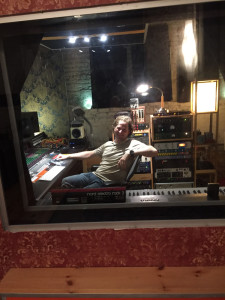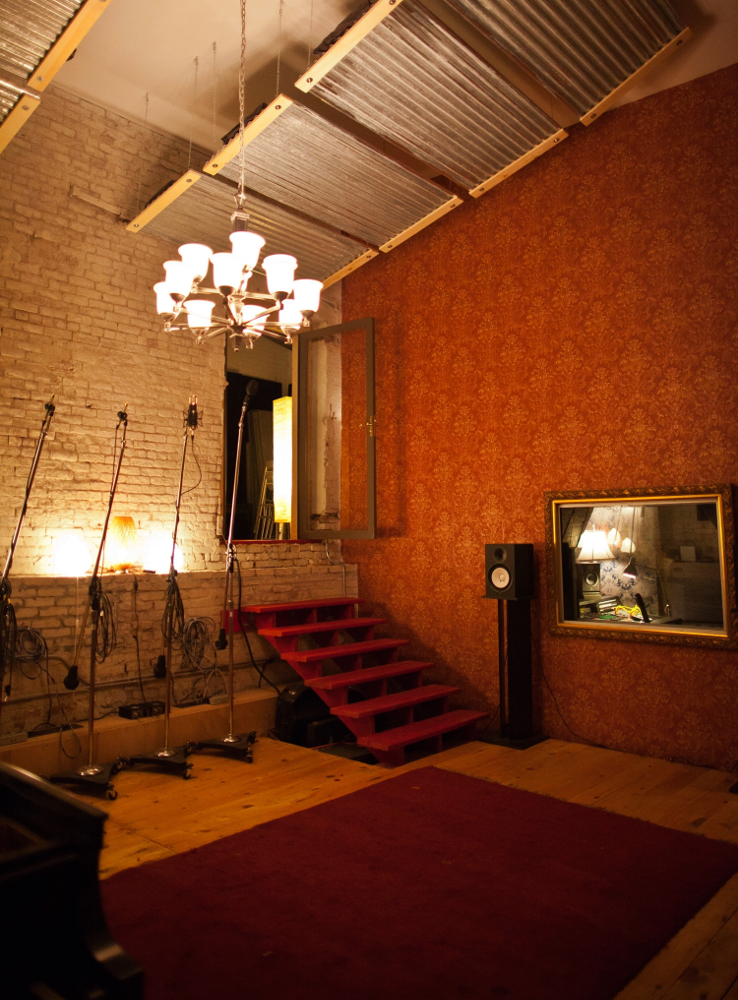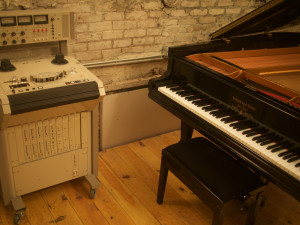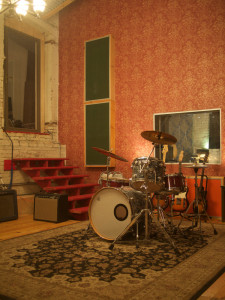From Engineer to Owner: The Intriguing Track of Reed Black and Vinegar Hill Sound
It could happen to you: One minute you’re engineering at the studio that you’ve grown to love, and the next minute… you’re the studio’s owner.
That’s a leap that does take place in the studio world, and most recently at Vinegar Hill Sound (VHS) in Brooklyn. Reed Black met the facility’s founder, Justin King, five years ago and found that the two had plenty in common. A busy freelance engineer at the time, Black tuned into King’s audio outlook and eventually moved into VHS with his gear.
In March of this year King decided to move on from the NYC studio he started, and Black went from engineer in residence to the proprietor of Vinegar Hill Sound. It’s good to be making the decisions, but with great power comes great responsibility, and Black is frank about the transitions he’s dealt with since heading up VHS.
He’s got something important to oversee: Named for the neighborhood it’s situated in, Vinegar Hill Sound is part of a beautiful Brooklyn district where the city’s historic charm still can be seen and felt. Inside its walls, an exacting collection of analog gear and classic microphones, big live spaces with 16-foot ceilings, a deeply soulful 1906 Steinway O piano, and much more create new sounds in this old enclave.
In the conversation below, Black opens up on the challenges and opportunities that have opened up to him since taking the reins. But one thing is clear – Vinegar Hill Sound is in the hands of a man who is incredibly passionate about audio. Best yet, you can meet him and see the facility for yourself this Thursday, October 15th, when VHS (46 Bridge Street, Brooklyn) holds its Grand Reopening Party FROM 7-10 PM. RSVP to info@vinegarhillsound.com.
For those who aren’t familiar with the studio’s history, get us caught up – when was it founded, and why?
Vinegar Hill Sound was founded in 2010 by musician and long-time studio owner Justin King. He came to Brooklyn from his home state of Oregon, where he had had a previous studio for years. VHS was significantly smaller at that point – about half the size that it is now.
It was just the essentials: a control room, a live room and an isobooth, with a small lounge. The larger footprint came later, which includes a large front lounge with huge windows, a kitchenette, and a mix room upstairs.
Reed, you’ve followed an interesting path towards becoming the studio’s owner. How did you first get involved with Vinegar Hill, and how did that eventually lead to you turning into its proprietor?
I first met Justin through a mutual friend in late 2010. As it turned out, we had a lot of musical history in common – significantly, we had both made records with the great producer Rob Schnapf in our youths. We also turned out to have many musical friends in common, and both had a very similar idea about what makes a studio great.
We got to talking, and I think it became clear pretty quickly that we should be working together. I was a freelancer at the time, working out of whatever studio my clients chose. Not having a home-base always makes things complicated for your bands, and once you’re actually making the record, you’re as much a guest in the space as the band you’re working with.
It’s hard to keep a firm grip on the session’s trajectory when you don’t know your way around the patchbay, or where the drum kit sounds best, or which channels on the board are a little wonky. You’re also constantly involved in three-way conversations with studio managers that get tiring. So when Justin and I met, and got into the details of both our visions for the future, I decided to jump right in, move my gear in and called it home.
It was great, because our gear fit together as well as our visions did. Justin had a set of V72s, I had a set of Manleys. Justin had a pair of 1176s, I had a pair of Chandler TG1s. He had a set of vintage Neve pres, I had a 33609 (rev A). He had a set of tube M260s, I had a set of KM184s. I don’t think we had a single piece of gear in common, so we effectively doubled our arsenals.
You and Justin also found you had some other key things about yourselves that were complementary, correct?
Yes, much more importantly, we valued two things that were somewhat unusual.
One, we both felt strongly that bands do their best work in a studio that feels like home. We both agreed that a studio should be a no-pressure workshop for creative exploration – not a corporate-feeling, personality-free office where you make sworn statements that will be held against you. I mean, look, once a record is released, you’re already going to receive a barrage of criticism based on other people’s expectations. While you’re actually creating your art, you should be responding to no one’s expectations other than your own, and those of the producer you have decided to trust as your guide and protector.
I remember one of my first times tracking as a musician in a big studio. I was in the live room at Cello Studio, which had formerly been United Western Recorders, where Pet Sounds was recorded. Now Cello was a phenomenal studio, and I have nothing but love for legendary studios like that – but I remember literally trembling as I sat down at the piano: “Could I possibly perform anything that justified brushing spirits with the legendary Brian Wilson? Could I do what he did?”
It was like I was getting crushed by an avalanche of outside expectations before the engineer even pushed “record,” or I played a single note. “This isn’t MY space,” I thought, “this is Bill Putnam’s space. This is Brian Wilson’s space.”
What Justin created with VHS was almost like a destination studio where people could go to get away from all that. No one’s vision but your own. No challenges but the ones you set out yourself. It’s a place where you remember that the studio isn’t a judge, it isn’t a cage – a studio is freedom. A studio is emancipation. It’s the freedom to dream, the freedom to truly be yourself.
That is a truly inspirational way to look at it. On the technical tip, how has the studio evolved since you first started working there?
Well, we always had a rolling turnover of gear and instruments, but when Justin left, he took his gear with him and I raced to replace the big components with the best I could pull together.
I’ve replaced the concert Baldwin piano with a breath-taking 1906 Steinway O. It’s one of the deepest, most soulful pianos I have ever played. I added a Bock 251 and a Soundelux U95 as my primary tube vocal mics. I also upgraded the converters from Lynx Auroras to a Burl Mothership, which in my opinion is the converter that has finally brought digital to adulthood. I brought in my Otari MTR-12 1/4″ master tape machine for my mixes, and a set of DynAudio BM15s that pair gorgeously with the control room. I routinely have people ask what kind of a sub I have, and they’re shocked to learn I have none!!
I brought in a bunch of my favorite dynamic mics too – Beyer M201s, a bunch of 421s, Placid Audio Copperphones and their new, as-of-yet unreleased Resonator Mic; a 441, an RE11 and RE20… Then I’ve also got some great workhorse condensers such as my KM184s, Audio-Technica 4051s, Michael Joly-modded Oktava MK12s and Rode NT1s… and then my favorite ribbons: Coles 4038s, a pair of Beyer M260 hypercardioids, and R121s for guitar amps. It’s a nice collection where I always feel like I have what I need to take us where we’re going.
You said that the current gear collection is tailored to how you like to do things. Can you expand on that – what does that mean in terms of your preferred workflow, and the type of sound you like to get?
For the majority of bands I work with, we are trying to get an old-school analog vibe without an old-school, six-figure analog budget. I know I’m not alone in this – Everyone’s working with less now, but I don’t believe that should prevent us from continuing to make luscious records.
So my strategy is to use time and gear in ways that don’t require an expensive analog recall just to, say, turn up the glockenspiel in the third chorus. That’s why I have a pretty robust collection of analog compressors, EQs and effects that I use as inserts until the mix is locked, at which point I print them all. I’ve found that’s the most transparent way possible to give people that living, breathing analog feel without forcing people to abandon their affordable digital habits.
Then when I track, I try to be as radical and aggressive as I can while knowing that we don’t have the budget to retake an entire vocal because I scorched it during the last chorus. So I often take a safety track that’s multed directly out of the preamp so that if my “move” fails us, we don’t risk losing hours or days.
It’s interesting that I actually rarely need to use them, but simply having that escape hatch allows me to take sounds that are closer to the final mix without frightening anyone.
Those techniques definitely reflect experience in the studio. Is there a recent project you can point to where you applied these aesthetics?
I was very excited about an EP I did this past August with a young band called Foxtrax — their record’s called The Cabin. The arrangements are pretty stripped-down since they’re a three-piece, so we tried to give every element enough character to fill the stage and become something unique.
I’m also a huge fan of the record I did last year with singer-songwriter Anthony Farina, whose EP The Color Wheel we actually tracked in the A room of Studio G. Anthony is the consummate musician and band-leader, and his solidity and confidence gave me a huge opportunity to explore the depths each instrument could plumb. We’re doing another one next month, so I’m psyched to see how we’ve both grown and changed since then.
I’m finishing up a full-length now with Noble Kin that’s going to be amazing. I was very proud of the sounds and overall mood we got on the last record, Cornish Litany. That was really a superior performance on his part, and the songwriting is spectacular.
As usual, I’m most handsome when I stand next to someone even handsomer – so when you’re recording and mixing material as deep as that, it’s hard to make a bad move. But in the end, I think we really created a sonic space that was completely unique.
Vinegar Hill Sound recently built a mix room for a private client upstairs. Was that an easy or difficult addition to take on? Do you have other spaces at the studio that you can develop as private studios?
As soon as I took over the space, I built out a mix room upstairs for my long-time collaborator and partner-in-crime, Eben D’Amico. He’s an amazing producer, and is probably the person I worked with most frequently over the last handful of years, so it was a no-brainer that I wanted him on board. As luck would have it, he had just given up his mix room in Bushwick and was looking for a new home, so everything dovetailed perfectly.
How hard was it? Build-out in NYC is hard, period. You’re always fighting against the elements like someone screaming at a tornado. Tripling your drywall, isolating any hard mechanical connections to other, noisier rooms, hanging your doors and glass with a finickiness as no homeowner would ever understand…
It’s always more work, and more expensive, than you expected. But the playing field is even – all NYC studio owners are fighting the same battles, and then reaping the same benefit: that your studio is in New York. In the end, you can’t beat that.
Sure, if I had the same studio in the middle of Montana it would be five times the size and I’d have a dozen U47s. But when you stepped out the door, you wouldn’t have the density of phenomenal people that makes this city so great.
Speaking of NYC, how are you seeing the Brooklyn recording scene changing?
Well, we all know the big studios are closing by the day, and Avatar may sadly be the next to join the heap. But I’m struck by how thick and vibrant the spirit of creativity is in Brooklyn. From Joel Hamilton and Tony Maimone’s incredible creation at Studio G, to Mark Alan Goodman’s Strange Weather, to Adam Lasus’ Room 17, and even to some of the smaller places that pop up every month, I think New York City is as important a creative center as ever.
The real thing that has seemed to remain steady for the last decade or two is the number of great and truly unique musicians who flock here from every part of the world. You can’t beat that. I think the studios are here because the bands are here, and it’s a self-feeding cycle that doesn’t seem to be ebbing at all.
Those are positive observations. Finally, how would you characterize your journey from being a studio’s engineer to its owner?
Mo’ responsibilities, mo’ problems!! There’s no question that being the ultimate decision-maker for a space is a lot more stressful than simply coming in and getting to work.
But I can do absolutely everything just the way I want, the way I think most benefits the work I can do for the great bands who are depending on me. So how has it been exciting and rewarding? It’s my dream come true!!
We’re glad to hear that Reed! Anything else?
Make music. In every way possible. It’s all part of one great river that connects us all.
— David Weiss
Don’t just read Reed Black — experience his viewpoint on recording:

Please note: When you buy products through links on this page, we may earn an affiliate commission.










